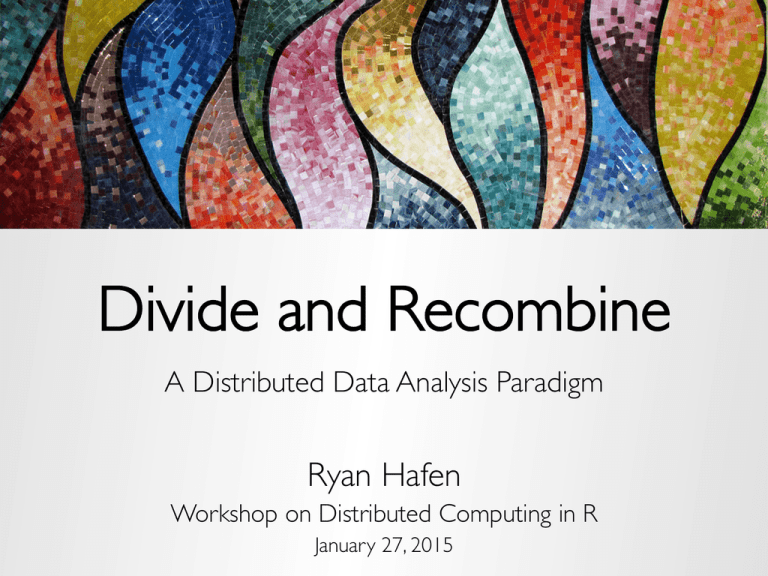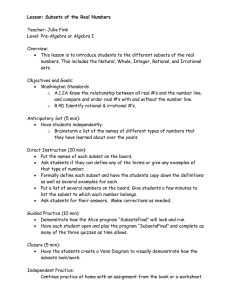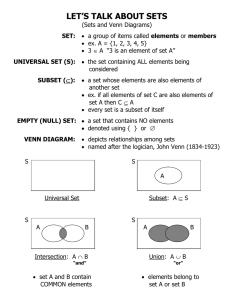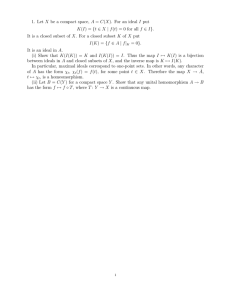Divide and Recombine - A Distributed Data Analysis Paradigm
advertisement

Divide and Recombine
A Distributed Data Analysis Paradigm
Ryan Hafen
Workshop on Distributed Computing in R
January 27, 2015
GOAL: DEEP ANALYSIS OF
LARGE COMPLEX DATA
» Large complex data has any or all of the following:
– Large number of records
– Many variables
– Complex data structures not readily put into tabular
form of cases by variables
– Intricate patterns and dependencies that require
complex models and methods of analysis
– Not i.i.d.!
What we want to be able to do (with large complex data)
» Work completely in R
» Have access to R’s1000s of statistical, ML, and vis methods
ideally with no need to rewrite scalable versions
» Be able to apply any ad-hoc R code to any type of distributed
data object
» Minimize time thinking about code or distributed systems
» Maximize time thinking about the data
» Be able to analyze large complex data with nearly as much
flexibility and ease as small data
Divide and Recombine (D&R)
» Simple idea:
– specify meaningful, persistent divisions of the data
– analytic or visual methods are applied independently
to each subset of the divided data in embarrassingly
parallel fashion
– Results are recombined to yield a statistically valid
D&R result for the analytic method
» D&R is not the same as MapReduce (but makes
heavy use of it)
Subset
Output
Result
Subset
Output
Statistic
Recombination
Subset
Output
Subset
Output
Subset
Output
Subset
Output
New Data
for Analysis
Sub-Thread
Data
Divide
One Analytic Method
of Analysis Thread
Analytic
Recombination
Visual
Displays
Visualization
Recombination
Recombine
How to Divide the Data?
» It depends!
» Random replicate division
– randomly partition the data
» Conditioning variable division
– Very often data are “embarrassingly divisible”
– Break up the data based on the subject matter
– Example:
•
•
•
•
25 years of 90 daily financial variables for 100 banks in the U.S.
Divide the data by bank
Divide the data by year
Divide the data by geography
– This is the major division method used in our own analyses
– Has already been widely used in statistics, machine learning,
and visualization for datasets of all sizes
Analytic Recombination
» Analytic recombination begins with applying an analytic
method independently to each subset
– The beauty of this is that we can use any of the small-data
methods we have available (think of the 1000s of methods in R)
» For conditioning-variable division:
– Typically the recombination depends mostly on the subject matter
– Example:
• subsets each with the same model with parameters (e.g. linear model)
• parameters are modeled as stochastic too: independent draws from a
distribution
• recombination: analysis to build statistical model for the parameters using
the subset estimated coefficients
Analytic Recombination
» For random replicate division:
– Observations are seen as exchangeable, with no conditioning variables
considered
– Division methods are based on statistical matters, not the subject matter as in
Our Approach: BLB
conditioning-variable division
– Results are often approximations
» Approaches that fit this paradigm
(1)
(1)
X̌1 , . . . , X̌b(n)
– Bag of little bootstraps
✓ˆn⇤(1)
⇤(2)
, . . . , Xn⇤(2)
✓ˆn⇤(2)
X1
..
.
X1
..
.
⇠(✓ˆn⇤(1) , . . . , ✓ˆn⇤(r) ) = ⇠1⇤
✓ˆn⇤(r)
, . . . , Xn⇤(r)
..
.
X1 , . . . , Xn
⇤(1)
(s)
(s)
X̌1 , . . . , X̌b(n)
– Alternating direction method of multipliers (ADMM)
avg(⇠1⇤ , . . . , ⇠s⇤ )
, . . . , Xn⇤(1)
✓ˆn⇤(1)
⇤(2)
X1 , . . . , Xn⇤(2)
✓ˆn⇤(2)
X1
– Consensus MCMC
» Ripe area for research
, . . . , Xn⇤(1)
⇤(r)
– Coefficient averaging
– Subset likelihood modeling
⇤(1)
X1
..
.
⇤(r)
X1
, . . . , Xn⇤(r)
..
.
✓ˆn⇤(r)
⇠(✓ˆn⇤(1) , . . . , ✓ˆn⇤(r) ) = ⇠s⇤
Visual Recombination
» Data is split into meaningful subsets, usually
conditioning on variables of the dataset
» For each subset:
– A visualization method is applied
– A set of cognostics, metrics that identify attributes of
interest in the subset, are computed
» Recombine visually by sampling, sorting, or
filtering subsets based on the cognostics
» Implemented in the trelliscope package
Data structures for D&R
» Must be able to break data down into pieces for
independent storage / computation
» Recall the potential for: “Complex data structures not
readily put into tabular form of cases by variables”
» Key-value pairs
– represented as lists of R objects
– named lists is a possibility but we want keys to be
able to have potentially arbitrary data structure too
– instead we can use lists for keys and values
– can be indexed by, for example, character hash of key
[[1]]!
$key!
[1] "setosa"!
!
$value!
Sepal.Length Sepal.Width Petal.Length Petal.Width!
1
5.1
3.5
1.4
0.2!
2
4.9
3.0
1.4
0.2!
3
4.7
3.2
1.3
0.2!
4
4.6
3.1
1.5
0.2!
5
5.0
3.6
1.4
0.2!
...!
!
!
[[2]]!
$key!
[1] "versicolor"!
!
$value!
Sepal.Length Sepal.Width Petal.Length Petal.Width!
51
7.0
3.2
4.7
1.4!
52
6.4
3.2
4.5
1.5!
53
6.9
3.1
4.9
1.5!
54
5.5
2.3
4.0
1.3!
55
6.5
2.8
4.6
1.5!
...!
Distributed data objects (ddo)
» A collection of k/v pairs that constitutes a set of data
» Arbitrary data structure (but same structure across
subsets)
> irisDdo!
!
Distributed data object backed by 'kvMemory' connection!
!
attribute
| value!
----------------+--------------------------------------------!
size (stored) | 12.67 KB!
size (object) | 12.67 KB!
# subsets
| 3!
!
* Other attributes: getKeys()!
* Missing attributes: splitSizeDistn!
Distributed data frames (ddf)
» A distributed data object where the value of each keyvalue pair is a data frame
» Now we have more meaningful attributes (names,
number of rows & columns, summary statistics, etc.)
> irisDdf!
!
Distributed data frame backed by 'kvMemory' connection!
!
attribute
| value!
----------------+-----------------------------------------------------!
names
| Sepal.Length(num), Sepal.Width(num), and 3 more!
nrow
| 150!
size (stored) | 12.67 KB!
size (object) | 12.67 KB!
# subsets
| 3!
!
* Other attrs: getKeys(), splitSizeDistn(), splitRowDistn(), summary()!
D&R computation
» MapReduce is sufficient for all D&R operations
– Everything uses MapReduce under the hood
– Division, recombination, summaries, etc.
http://tessera.io
TESSERA
Software for Divide and Recombine
» D&R Interface
– datadr R package: R implementation of D&R that
ties to scalable back ends
– Trelliscope R package: scalable detailed visualization
» Back-end agnostic design
Interface
Computation
Storage
datadr / trelliscope
MapReduce
Key/Value Store
Supported back ends (currently)
And more… (like Spark)
What does a candidate back end need?
» MapReduce
» Distributed key-value store
» Fast random access by key
» Ability to broadcast auxiliary data to nodes
» A control mechanism to handle backend-specific
settings (Hadoop parameters, etc.)
» To plug in, implement some methods that tie to
generic MapReduce and data connection classes
datadr
» Distributed data types / backend connections
– localDiskConn(), hdfsConn(), sparkDataConn()
connections to ddo / ddf objects persisted on a
backend storage system
– ddo(): instantiate
a ddo from a backend connection
– ddf(): instantiate
a ddf from a backend connection
» Conversion methods between data stored on
different backends
datadr: data operations
» divide(): divide a ddf by conditioning variables or randomly
» recombine(): take the results of a computation applied to a
»
»
»
»
»
»
»
ddo/ddf and combine them in a number of ways
drLapply(): apply a function to each subset of a ddo/ddf
and obtain a new ddo/ddf
drJoin(): join multiple ddo/ddf objects by key
drSample(): take a random sample of subsets of a ddo/ddf
drFilter(): filter out subsets of a ddo/ddf that do not
meet a specified criteria
drSubset(): return a subset data frame of a ddf
drRead.table() and friends
mrExec(): run a traditional MapReduce job on a ddo/ddf
maxMap <- expression({!
for(curMapVal in map.values)!
collect("max", max(curMapVal$Petal.Length))!
})!
!
maxReduce <- expression(!
pre = {!
globalMax <- NULL!
},!
reduce = {!
globalMax <- max(c(globalMax, unlist(reduce.values)))!
},!
post = {!
collect(reduce.key, globalMax)!
}!
)!
!
maxRes <- mrExec(hdfsConn("path_to_data"),!
map = maxMap,!
reduce = maxReduce!
control =!
)!
maxMap <- expression({!
for(curMapVal in map.values)!
collect("max", max(curMapVal$Petal.Length))!
})!
!
maxReduce <- expression(!
pre = {!
globalMax <- NULL!
},!
reduce = {!
globalMax <- max(c(globalMax, unlist(reduce.values)))!
},!
post = {!
collect(reduce.key, globalMax)!
}!
)!
!
maxRes <- mrExec(sparkDataConn("path_to_data"),!
map = maxMap,!
reduce = maxReduce!
control =!
)!
maxMap <- expression({!
for(curMapVal in map.values)!
collect("max", max(curMapVal$Petal.Length))!
})!
!
maxReduce <- expression(!
pre = {!
globalMax <- NULL!
},!
reduce = {!
globalMax <- max(c(globalMax, unlist(reduce.values)))!
},!
post = {!
collect(reduce.key, globalMax)!
}!
)!
!
maxRes <- mrExec(localDiskConn("path_to_data"),!
map = maxMap,!
reduce = maxReduce!
control =!
)!
maxMap <- expression({!
for(curMapVal in map.values)!
collect("max", max(curMapVal$Petal.Length))!
})!
!
maxReduce <- expression(!
pre = {!
globalMax <- NULL!
},!
reduce = {!
globalMax <- max(c(globalMax, unlist(reduce.values)))!
},!
post = {!
collect(reduce.key, globalMax)!
}!
)!
!
maxRes <- mrExec(data,!
map = maxMap,!
reduce = maxReduce!
control =!
)!
datadr: division-independent methods
» drQuantile(): estimate
»
»
»
all-data quantiles,
optionally by a grouping variable
drAggregate(): all-data tabulation
drHexbin(): all-data hexagonal binning
aggregation
summary() method computes numerically stable
moments, other summary stats (freq table,
range, #NA, etc.)
# divide home price data by county and state!
byCounty <- divide(housing, !
by = c("county", "state"), update = TRUE)!
!
# look at at summary statistics for the variables!
summary(byCounty)!
!
# compute all-data quantiles of median list price!
priceQ <- drQuantile(byCounty, var = "medListPriceSqft")!
!
# apply transformation to each subset!
lmCoef <- function(x)!
coef(lm(medListPriceSqft ~ time, data = x))[2]!
byCountySlope <- addTransform(byCounty, lmCoef)!
!
# recombine results into a single data frame!
countySlopes <- recombine(byCountySlope, combRbind)!
!
# divide another data set with geographic information!
geo <- divide(geoCounty, by = c("county", "state"))!
!
# join the subsets of byCounty and geo to get a joined ddo!
byCountyGeo <- drJoin(housing = byCounty, geo = geo)!
Considerations
» Distributed computing on large data means:
– distributed data structures
– multiple machines / disks / processors
– fault tolerance
– task scheduling
– data-local computing
– passing data around nodes
– tuning
» Debugging
» Systems
– Installation, updating packages, Docker,






